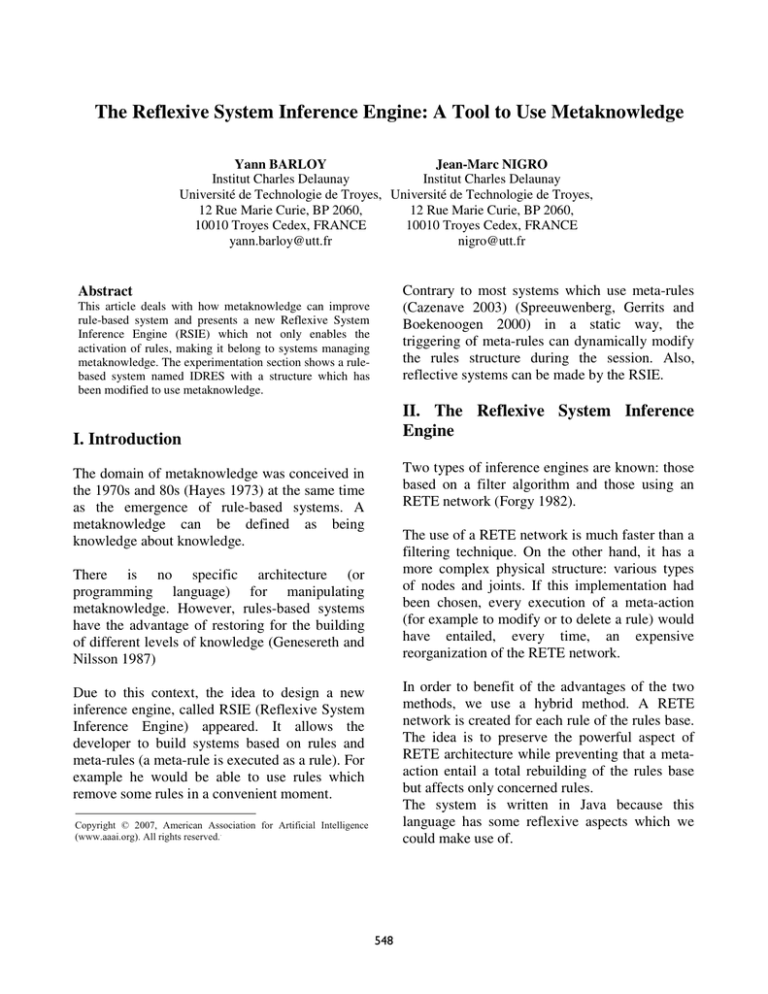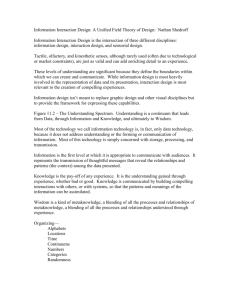
The Reflexive System Inference Engine: A Tool to Use Metaknowledge
Jean-Marc NIGRO
Yann BARLOY
Institut Charles Delaunay
Institut Charles Delaunay
Université de Technologie de Troyes, Université de Technologie de Troyes,
12 Rue Marie Curie, BP 2060,
12 Rue Marie Curie, BP 2060,
10010 Troyes Cedex, FRANCE
10010 Troyes Cedex, FRANCE
nigro@utt.fr
yann.barloy@utt.fr
Contrary to most systems which use meta-rules
(Cazenave 2003) (Spreeuwenberg, Gerrits and
Boekenoogen 2000) in a static way, the
triggering of meta-rules can dynamically modify
the rules structure during the session. Also,
reflective systems can be made by the RSIE.
Abstract
This article deals with how metaknowledge can improve
rule-based system and presents a new Reflexive System
Inference Engine (RSIE) which not only enables the
activation of rules, making it belong to systems managing
metaknowledge. The experimentation section shows a rulebased system named IDRES with a structure which has
been modified to use metaknowledge.
II. The Reflexive System Inference
Engine
I. Introduction
Two types of inference engines are known: those
based on a filter algorithm and those using an
RETE network (Forgy 1982).
The domain of metaknowledge was conceived in
the 1970s and 80s (Hayes 1973) at the same time
as the emergence of rule-based systems. A
metaknowledge can be defined as being
knowledge about knowledge.
The use of a RETE network is much faster than a
filtering technique. On the other hand, it has a
more complex physical structure: various types
of nodes and joints. If this implementation had
been chosen, every execution of a meta-action
(for example to modify or to delete a rule) would
have entailed, every time, an expensive
reorganization of the RETE network.
There is no specific architecture (or
programming language) for manipulating
metaknowledge. However, rules-based systems
have the advantage of restoring for the building
of different levels of knowledge (Genesereth and
Nilsson 1987)
In order to benefit of the advantages of the two
methods, we use a hybrid method. A RETE
network is created for each rule of the rules base.
The idea is to preserve the powerful aspect of
RETE architecture while preventing that a metaaction entail a total rebuilding of the rules base
but affects only concerned rules.
The system is written in Java because this
language has some reflexive aspects which we
could make use of.
Due to this context, the idea to design a new
inference engine, called RSIE (Reflexive System
Inference Engine) appeared. It allows the
developer to build systems based on rules and
meta-rules (a meta-rule is executed as a rule). For
example he would be able to use rules which
remove some rules in a convenient moment.
Copyright © 2007, American Association for Artificial Intelligence
(www.aaai.org). All rights reserved..
548
III. Experiments and assessment
Acknowledgements
RSIE was tested with a 3.00 GHz Pentium by
executing the rule-based system IDRES (Nigro
and Barloy 2006). IDRES system recognizes
maneuvers made by a vehicle from a sequence of
known data given by a set of proprioceptive
sensors.
It comprises ten rules and for each 0.010 s eight
facts are generated starting from the data of eight
sensors.
Research supported in part by ChampagneArdenne Regional Council (district grant) and the
European Social Fund.
References
Cazenave, T. 2003. Metarules to Improve
Tactical Go Knowlegde. Information Sciences,
154 (3-4):173-188.
Results shows that adding metarules to delete
rules which became useless allow to match less
rules and to gain in term of time of execution and
memory space. Indeed, the system creates 821
facts in 1.100 s without the meta-level and only
405 in 0.580 s with this level. The use of
metarules which create progressively relevant
rules allow to give only a restricted number of
initial rules to the system and optimize speed of
execution (0.500 s).
Forgy, C.L. 1982. Rete : A Fast Algorithme for
the Many Pattern / Many Object Pattern Match
Problem. Artificial Intelligence, 19.
Genesereth, M.R., and Nilsson N.J. 1987.
Logical Fundations of Artificial Intelligence, Los
Altos, CA Morgan Kaufmann.
Hayes, P.J. 1973. Computation and deduction.
Proc. 2nd. Symposium on Mathematical
Foundations
of
Computer
Science,
Czechoslovakian Academy of Sciences, 105-118.
The structure used to develop and to use RSIE
allows the conception of meta-rules, metaconditions or meta-actions as easily as one rule.
It also authorizes the creation of reflexive metarules (which apply to themselves) without having
to duplicate knowledge (Kormann 1996).
Another advantage is that the reflexive system
inferences engine is able to execute these metarules during the execution. It authorizes the
development of learning techniques in real time
or in very dynamic domains environment (like
assistance in driving cars).
Kornman, S. 1996. Infinite Regress with selfmonitoring. Reflection'96 Conference :221-233.
San Francisco.
Nigro, J.M., and Barloy, Y. 2006. The Meta
Inferences Engine : a tool to use metaknowledge,
IPMU 06, Paris.
Spreeuwenberg,
S.,
Gerrits,
R.,
and
Boekenoogen, M. 2000. VALENS: A
Knowledge Based Tool to Validate and Verify an
Aion Knowledge Base. ECAI 2000:731- 735.
IV. Conclusion
The reflexive system inferences engine is still in
development and this article shows the first
results of the core around whose will be
implemented the final version. It is useful for the
development of metaknowledge. In the future,
new functionalities will be added to RSIE to
make it more efficient.
549




